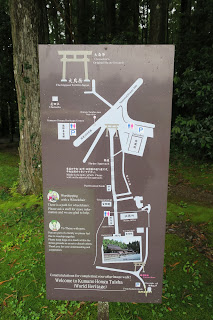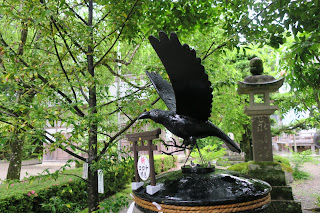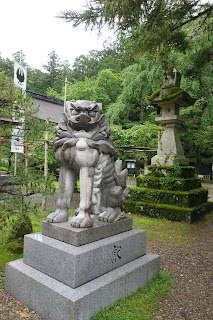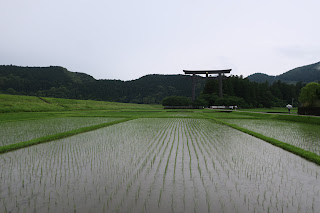Kumano Hongu Taisha is a Shinto shrine located in the jurisdiction of Tanabe,
Wakayama, deep in the rugged mountains of the southeast Kii Peninsula of
Japan.
The main deity enshrined is Kumano Gongen. All of the ancient Kumano Kodo
routes lead to the Grand Shrine.
It was originally located at present Oyunohara, on a sandbank at the
confluence of the Kumano River and Otonashi River. In 1889, it was partially
destroyed in a flood and the remaining shrine buildings were relocated at its
present site in 1891. Of the original five main pavilions only three were
rebuilt. Four deities were moved there and the other eight are still enshrined
there in two stone monuments.
In 2000, the largest torii shrine gate in the world (33.9 meters tall and 42
meters wide) was erected at the entrance to the Oyunohara sandbank. It is an
official gateway that designates the entrance to a sacred area. It signifies
the division of the secular and the spiritual worlds. This torii is called
Otorii (o means "great") and is made of steel weighing 172 tons, which took
about six months to make and another six months to assemble.
|
Kumano Hongu Taisha Shrine map.
Over 900 years ago a pilgrim wrote of a massive shrine grounds including
five main pavilions enshrining 12 deities. Numerous other small temples
and shrines could be found surrounding the main buildings.
-
Over the centuries the pavilions were partially destroyed by periodic
fires and flooding, but always faithfully rebuilt to their original
state. The last fire was in 1776 and the buildings rebuilt again in
1803.
-
After the flood of 1889, the shrine pavilions were moved and rebuilt
at their present location.
|
|
Entering Kumano Hongu Taisha Shrine.
The main entrance is to the south.
|
|
First torii of Kumano Hongu Taisha (Ichi-no-Tori'i).
The function of a torii is to mark the entrance to a sacred space. For
this reason, the road leading to a Shinto shrine (sando) is
almost always straddled by one or more torii.
-
If the sando passes under multiple torii, the outer of them is
called ichi no torii (first torii).
-
See more at
Torii - Wikipedia.
|
|
Shrine approach.
In the middle is the Deity's Path. Please walk on the sides of the
approach.
|
|
Koreisha shrine.
This shrine is dedicated to the heroic spirits of the war dead in the
Greater East Asia and the Russo-Japanese War.
|
|
Staircase with 158 steps.
The 158 stone steps leading to the main hall are lined on both sides
with Kumano Daigongen banners, and the surrounding thick cedars evoke
the shrine's history.
|
|
Water ablution pavilion (Chozuya).
Chozu-ya or temizu-ya is a Shinto water ablution pavilion for a
ceremonial purification rite known as temizu or chozu
(lit. 'hand-water'). The pavilion contains a large water-filled basin
called a chozubachi ('hand water basin').
-
At shrines, these chozubachi are used by worshippers for washing their
left hands, right hands, mouth and finally the handle of the water
ladle to purify themselves before approaching the main Shinto shrine
or shaden.
-
This symbolic purification is normal before worship and all manned
shrines have this facility, as well as many Buddhist temples and some
new religious houses of worship.
-
See more at
Chōzuya - Wikipedia.
|
|
Stamp office with small kamidana with ofuda.
A household kamidana is typically set up in one's home to enshrine an
ofuda, a type of charm. Both kamidana and ofuda can be obtained at any
large Shinto shrine.
-
Kamidana (lit. 'god/spirit-shelf') are miniature household altars
provided to enshrine a Shinto kami.
-
The kamidana is typically placed high on a wall and contains a wide
variety of items related to Shinto-style ceremonies.
-
Worship at the kamidana typically consists of the offering of simple
prayers, food (e.g., rice, fruit, water) and flowers.
-
See more at
Kamidana - Wikipedia.
-
In Shinto and Buddhism in Japan, an ofuda (honorific form of fuda,
'slip [of paper], card, plate') is a talisman made out of various
materials such as paper, wood, cloth or metal.
-
Ofuda are commonly found in both Shinto shrines and Buddhist temples
and are considered to be imbued with the power of the deities (kami)
or Buddhist figures revered therein.
-
A specific type of ofuda is a talisman issued by a Shinto shrine on
which is written the name of the shrine or its enshrined kami and
stamped with the shrine's seal. Such ofuda are often placed on
household Shinto altars (kamidana) and revered both as a symbol of the
shrine and its deity (or deities) – containing the kami's essence or
power by virtue of its consecration – and a medium through which the
kami in question can be accessed by the worshiper. In this regard they
are somewhat similar to (but not the same as) goshintai,
physical objects which serve as repositories for kami in Shinto
shrines.
-
In a similar vein, Buddhist ofuda are regarded as imbued with the
spirit and the virtue of buddhas, bodhisattvas, or other revered
figures of the Buddhist pantheon, essentially functioning in many
cases as a more economic alternative to Buddhist icons and statuary.
-
See more at
Ofuda - Wikipedia.
|
|
Emperor Gotoba Imperial Poetry Monument.
«I wonder if I can see the Onmu-gawa river today by dividing all the way
from the Sakashiki Peak. Made by Emperor Gotoba.»
-
Emperor Go-Toba (Go-Toba-tennō, August 6, 1180 – March 28, 1239) was
the 82nd emperor of Japan, according to the traditional order of
succession. His reign spanned the years from 1183 through 1198.
-
Among all arts, his skill in Japanese poetry might be said to leave
one at a loss for superlatives.
-
See more at
Emperor Go-Toba - Wikipedia.
|
|
Poster teaching how to worship.
«Who to worship: 1. Bow deeply twice, 2. Clap twice, 3. Pray
wholeheartedly, 4. Bow deeply once.»
|
|
Three-legged crow (Yatagarasu).
The three-legged (or tripedal) crow is a mythological creature in
various mythologies and arts of East Asia. It is believed to inhabit and
represent the Sun.
-
In Japanese mythology, this flying creature is a raven or a jungle
crow called Yatagarasu (eight-span crow) and the appearance of the
great bird is construed as evidence of the will of Heaven or divine
intervention in human affairs.
- Yatagarasu as a crow-god is a symbol specifically of guidance.
-
In the Three Great Shrines of Kumano (Kumano Sanzan), Yatagarasu is
worshiped as a servant of the Susanoo-no-Mikoto, the Great God of
Kumano, and is also a symbol of Kumano.
-
The three-legged crow shown above represents the Kumano Hongu shrine.
The three-legged crow shown at the bottom left represents the Kumano
Nachi shrine. The three-legged crow shown at the bottom right
represents the Kumano Hayatama shrine.
-
See more at
Yatagarasu - Wikipedia.
|
|
Yatagarasu Post Box.
A black Yatagarasu post box is installed in front of the office
building.
|
|
Water ablution pavilion (Chozuya) with dragons.
The Chinese dragon, also known as the loong, long or lung, is a
legendary creature in Chinese mythology, Chinese folklore, and Chinese
culture at large.
-
Chinese dragons have many animal-like forms such as turtles and fish,
but are most commonly depicted as snake-like with four legs.
-
They traditionally symbolize potent and auspicious powers,
particularly control over water.
-
The dragon is also a symbol of power, strength, and good luck for
people who are worthy of it in East Asian culture.
-
In Chinese culture, excellent and outstanding people are compared to a
dragon, while incapable people with no achievements are compared to
other, disesteemed creatures, such as a worm.
-
The impression of dragons in a large number of Asian countries has
been influenced by Chinese culture, such as in Korea, Vietnam, and
Japan.
-
See more at
Chinese dragon - Wikipedia.
|
|
Votive plaques (Ema).
Ema (lit. 'picture-horse') are small wooden plaques, common to Japan, in
which Shinto and Buddhist worshippers write prayers or wishes. Ema are
left hanging up at the shrine, where the kami (spirits or gods) are
believed to receive them.
-
Typically 15 cm (5.9 in) wide and 9 cm (3.5 in) tall, they often carry
images or are shaped like animals, or symbols from the zodiac, Shinto,
or the particular shrine or temple.
-
Once inscribed with a wish, ema are hung at the shrine until they are
ritually burned at special events, symbolic of the liberation of the
wish from the writer.
-
See more at
Ema (Shinto) - Wikipedia.
|
|
Guardian lion (Komainu).
The path that leads to the worship hall (Haiden) area is guarded by two
lions, one on each side.
-
Guardian lions (Komainu), often called lion-dogs in English, are
statue pairs of lion-like creatures either guarding the entrance or
the honden, or inner shrine of many Japanese Shinto shrines or kept
inside the inner shrine itself, where they are not visible to the
public.
-
Meant to ward off evil spirits, modern komainu statues usually are
almost identical, but one has the mouth open, the other closed. The
two forms are called a-gyō (lit. '"a" shape') and un-gyō (lit. '"un"
shape') or referred to collectively as a-un.
-
The open mouth is pronouncing the first letter of the Sanskrit
alphabet, which is pronounced "a", while the closed one is uttering
the last letter, which is pronounced "um", to represent the beginning
and the end of all things. Together they form the sound Aum, a
syllable sacred in several religions like Hinduism, Buddhism, and
Jainism.
-
See more at
Komainu - Wikipedia.
|
|
Great Black rock and Turtle rock (Kameishi).
The Great Black rock (top) is on the left side of the path to the hall
of worship. The Turtle rock (below) is on the right side of the path to
the hall of worship.
|
|
Three-legged crow medallion (Yatagarasu).
After the two rocks are two medallions, one on each side of the path,
with the figure of The three-legged crow (Yatagarasu).
|
|
Worship hall (Haiden).
In Shinto shrine architecture, the haiden is the hall of worship or
oratory. It is generally placed in front of the shrine's main sanctuary
(honden) and often built on a larger scale than the latter.
|
|
Shrine gate.
This gate is located on the right side of the Worship hall (Haiden) and
gives access to the Main hall (Honden).
|
|
Panoramic view of the Main hall (Honden).
Enshrining the kami, from left to right:
- Upper Four Shrines First Hall West Gozen (Husband Sumi Okami).
-
Upper Four Shrines Second Hall Middle Gozen (Hayatama Male God).
-
Upper Four Shrines Third Hall Shangsisha Shrine, the Hall of
Chengcheng (Iezu Miko Daishen).
- Upper Four Shrines Fourth Hall Wakamiya (Amaterasu Omikami).
-
The Kumano Hongu Taisha's pavilions are an outstanding example of
Japanese shrine architecture. The use of natural unfinished materials
allows it to blend effortlessly into the natural environment.
Intricate joint works were used in the construction instead of nails.
The thick roof gracefully sweeps forward extending over the stairs and
the area in front of the shrine. It is made entirely of hinoki,
Japanese cypress bark.
-
The bronze ornaments on the roof top are characteristic features of
shrine architecture. The X-shaped crosspieces that pierce the sky are
called Chigi and the log like beams that are laid horizontally along
and perpendicular to the ridge line are called Katsuogi. They add a
dramatic highlight to the roof line.
|
|
Emperor Shirakawa Monument.
Emperor Shirakawa (Shirakawa-tenno, 7 July 1053 – 24 July 1129) was the
72nd emperor of Japan, according to the traditional order of succession.
Shirakawa's reign lasted from 1073 to 1087.
-
He was the first emperor to ostensibly retire to a monastery, but in
fact continue to exert considerable influence over his successor. This
process would become known as cloistered rule.
-
See more at
Emperor Shirakawa - Wikipedia.
|
|
Izumi Shikibu Prayer Tower.
Izumi Shikibu (born 976?) was a mid-Heian period Japanese poet. She is a
member of the Thirty-six Medieval Poetry Immortals.
-
She is considered by many to have been the greatest woman poet of the
Heian period. Her legacy includes 242 poems and two kashu.
-
Torn between worldly ties and physical desire, Izumi Shikibu left a
wealth of passionate love poetry, fueling rumors that purported that
she was a femme fatale with numerous lovers besides her two husbands
and two princely lovers.
-
See more at
Izumi Shikibu - Wikipedia.
|
|
Worship hall (Haiden).
Worship hall seen from the Main hall.
|
|
Leaving Kumano Hongu Taisha Shrine.
This gate is located to the north of the shrine.
|
Kumano Hongu Taisha Original Site
|
Original site of Kumano Hongu Taisha.
Kumano Hongu Taisha was originally located at present Oyunohara, on a
sandbank at the confluence of the Kumano River and Otonashi River.
-
In 1889, it was partially destroyed in a flood and the remaining
shrine buildings were relocated at its present site in 1891.
|
|
Walking towards the original location.
To get to the original location we have to go through Oyunohara.
|
|
Rice fields.
In the distance, behind the rice fields, we can see the largest torii
shrine gate in the world.
|
|
Great torii (Otorii).
In 2000, the largest torii shrine gate in the world (33.9 meters tall
and 42 meters wide) was erected at the entrance to the Oyunohara
sandbank.
-
It is an official gateway that designates the entrance to a sacred
area. It signifies the division of the secular and the spiritual
worlds.
-
This torii is called Otorii ("o" means "great") and is made of steel
weighing 172 tons, which took about six months to make and another six
months to assemble.
|
|
Water-filled basin (Chozubachi).
A chozubachi, or water bowl, is a vessel used to rinse the hands in
Japanese temples, shrines and gardens.
-
At shrines, these chozubachi are used by worshippers for washing their
left hands, right hands, mouth and finally the handle of the water
ladle to purify themselves before approaching the main Shinto shrine
or shaden.
-
This symbolic purification is normal before worship and all manned
shrines have this facility, as well as many Buddhist temples and some
new religious houses of worship.
-
See more at
Chōzubachi - Wikipedia.
|
|
Entrance to the original location.
This was the sanctuary's original location until the 1889 flood.
|
|
Kumano Hongu Taisha Spring Festival photos.
The annual spring festival held 13–15 April every year is not only a
quintessential festival of Kumano but also intimately associated with
the pilgrimage to Kumano and the Kumano Kodo pilgrimage route.
-
On April 13 fathers and their young sons purify themselves in the
sacred waters of Yunomine Onsen before walking over the Dainichi-goe
section of the Kumano Kodo pilgrimage route to Oyunohara wearing
traditional costumes.
-
The young boys have the character for big on their forehead and are
forbidden to touch the ground. On April 15 the Kumano Deities are
invoked to temporarily take up residence in a portable mikoshi shrine
and returned to their original site of descend, Oyunohara.
- The atmosphere is serene, traditional, authentic and inspiring.
|
|
Leaving the original location.
|
See also
Source
Location
Fudarakusan-ji Temple
Kumano Nachi Taisha Shrine
Kumano Hayatama Taisha Shrine
Kumano Pilgrimage Route
Shugendo Religion












































